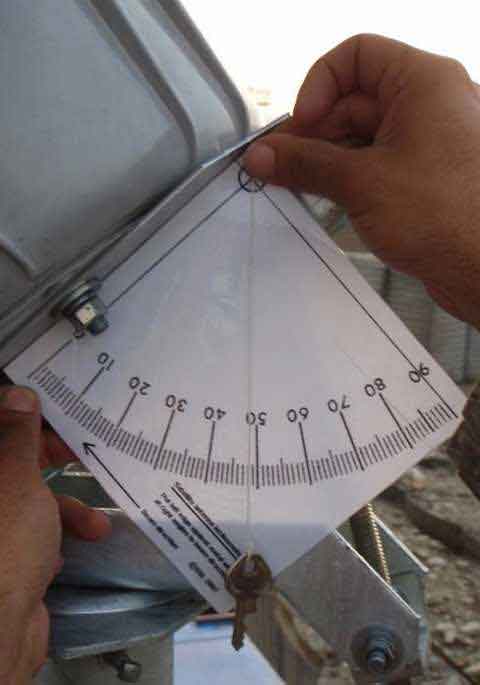|
Focal length of parabolic dish |
Setting the elevation of an offset dish
Most satellite TV dishes have a beam elevation angle scale on the bracket behind the dish.
1. Use elevation scale
If this applies to your dish:
Check that the pole is upright. Apply an inclinometer or spirit level to the vertical pole in two places around the pole at 90 deg to each other. Make sure the pole is accurately vertical.
Note that the clamp to the pole, when loose, will allow the dish to sag down a bit. This sagging will make the elevation scale readings wrong, by say 2 deg.
Set to the required angle, plus perhaps 2 deg.
Now swing the dish boldly sideways at the approximate azimuth compass bearing and you will find the satellite.
Once acquired, progressively tighten the clamp. The elevation angle will increase and you will need to adjust carefully until both azimuth and elevation are peaked. It is important to get to the exact center to minimise outage time in heavy rain.
2. Need to use inclinometer
If there is no beam elevation scale: The manufacturer documentation should tell you the dish offset angle. Example offset angles: 11.29, 12.02, 15.43, 16.15, 17.35, 22.6, 30 deg. The figure varies for each dish design and between manufacturers.
The figure below assumes a 30 deg offset.

Also, see below, look out for some part such as the rear surface of a wedge shaped metal or plastic box, or a length of metal forming part of the feed support strut that may be manufactured to be exactly in line with the beam, or at 90 deg to the beam direction. This example shows an inclinometer held against a surface at 90 deg to the beam direction (towards the upper left, beam elevation 48 deg).

The wedge shaped box has been manufactured to suit the particular dish.
The rear face is at right angles to the beam direction.
In this picture the beam elevation is 48 deg.
If you set the front face of your dish vertical the beam elevation will be the same as the offset angle.
You can use a string on a weight and put the string at the top front edge. The string should just touch at the bottom. Alternatively you might apply an inclinometer to the front side edge of the dish. The inclinometer reading will be 0 or 90 deg.
If the dish has been manufactured with a 30 deg offset, the beam elevation is now 30 deg. If you want 60.6 beam elevation angle you now need to increase the beam elevation angle by 60.6 - 30 = 30.6 deg. Tilt the top of the dish backwards by an amount of 30.6 deg.
Apply an inclinometer to some convenient place. Read the angle.
Tilt the top of the dish backwards and the inclinometer reading will change. Keep moving till the amount of change is 30.6 deg. Quite what the final reading will be will depend on the way you put the inclinometer, its starting reading is 0 or 90, and the direction of the change of numbers as you tilted the top of the dish backwards.
You have now set the beam elevation accurately to 60.6 deg.
Now swing the dish boldly sideways in the approximate azimuth compass bearing and you will find the satellite.
|
► Page created 1 Feb 2015, amended 14 March 2024. All pages on this satsig.net web site are Copyright Satellite Signals Limited 2009 all rights reserved. |